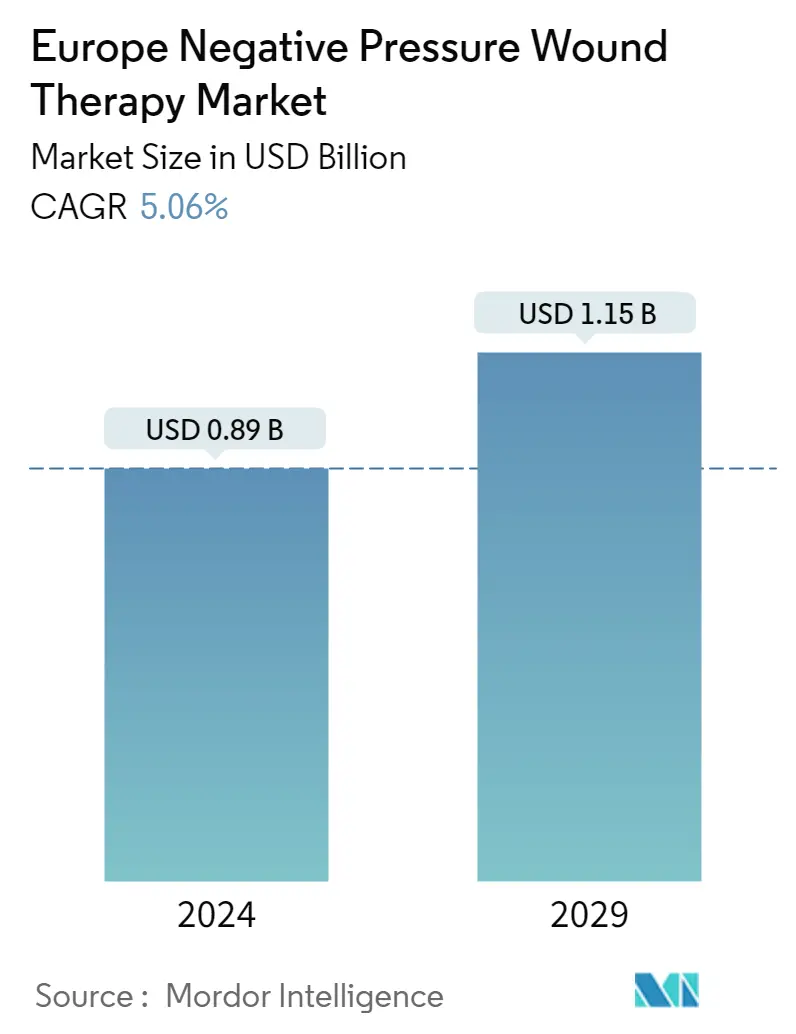Market Size of Europe Negative Pressure Wound Therapy Industry

| Study Period | 2019 - 2029 |
| Base Year For Estimation | 2023 |
| Market Size (2024) | USD 0.89 Billion |
| Market Size (2029) | USD 1.15 Billion |
| CAGR (2024 - 2029) | 5.06 % |
| Market Concentration | Medium |
Major Players
*Disclaimer: Major Players sorted in no particular order |
Europe Negative Pressure Wound Therapy Market Analysis
The Europe Negative Pressure Wound Therapy Market size is estimated at USD 0.89 billion in 2024, and is expected to reach USD 1.15 billion by 2029, growing at a CAGR of 5.06% during the forecast period (2024-2029).
The COVID-19 pandemic caused collateral damage in health care regarding reduced hospital submissions or postponed treatment of other acute or chronically ill patients. For instance, the article published in the International Wound Journal in February 2021 included sixty-three patients diagnosed with any kind of ulceration or chronic wound in the survey. Out of these, 14% of patients' diagnostic workup or hospitalization was cancelled or delayed. 36% could not visit their primary care physician as usual for advice. The survey indicated that Germany's COVID-19 pandemic impaired access to clinical management of chronic wounds. Thus, COVID-19 adversely impacted the studied market; however, as the pandemic has currently subsided, the market is expected to experience pre-pandemic growth levels during the study's forecast period.
In addition, the increasing number of accidents and traumatic events, rising chronic wounds such as diabetic foot ulcers, and technological advancements in NPWT devices are actively affecting the growth of the studied market.
For instance, an article published in Diabetes Research and Clinical Practice Journal in February 2021 stated that 69% (154) of patients in Germany and 70% (69) in Czech Republic experienced at least one diabetic foot ulcers (DFU) recurrence. The study stated that cumulative DFU recurrence was approximately 70% in 15 years in both groups. The high incidence of diabetic foot ulcers and its recurrence is expected to boost the demand for negative pressure wound therapy market.
Furthermore, according to the European Pressure Ulcer Advisory Panel 2022 report, Pressure Ulcer Day is hosted in November every year in Europe to spread awareness about the disease. The upcoming event was likely to be hosted in November 2022 with an aim to stop pressure ulcer. Such events are likely to spread awareness regarding the negative pressure wound therapy in the management of pressure ulcer which is projected to boost the growth of the studied market.
Therefore, owing to the aforementioned factors such as the rising prevalence of various chronic
wounds and the rising awareness about the treatment of chronic wounds, the studied market is anticipated to witness growth over the analysis period. however, the high cost of devices and treatment and complications associated With NPWT devices are likely to impede the market growth.
Europe Negative Pressure Wound Therapy Industry Segmentation
As per the scope of the report, negative-pressure wound therapy (NPWT) is a therapeutic technique using a suction dressing to remove excess exudation and promote healing in acute or chronic wounds and second and third-degree burns. This report covers the study of types of NPWT products and their applications across various injuries/ulcers. The Europe negative pressure wound therapy market is segmented by product (re-usable device and single-use device), wound type (diabetic foot ulcer, pressure ulcer, venous leg ulcer, burn wounds, and others), end-user (hospital, homecare, and others), and geography (Germany, United Kingdom, France, Italy, Spain, and Rest of Europe). The report offers the value (in USD) for the above segments.
| By Product | |
| Re-Usable Device | |
| Single-Use Device |
| By Wound Type | |
| Diabetic Foot Ulcer | |
| Pressure Ulcer | |
| Venous Leg Ulcer | |
| Burn Wounds | |
| Others |
| By End-User | |
| Hospital | |
| Homecare | |
| Others |
| Geography | |
| Germany | |
| United Kingdom | |
| France | |
| Italy | |
| Spain | |
| Rest of Europe |
Europe Negative Pressure Wound Therapy Market Size Summary
The Europe Negative Pressure Wound Therapy (NPWT) market is poised for significant growth over the forecast period, driven by a combination of factors including the rising prevalence of chronic wounds such as diabetic foot ulcers and the increasing incidence of accidents and traumatic events. Technological advancements in NPWT devices are also contributing to market expansion. The market experienced a temporary setback due to the COVID-19 pandemic, which disrupted access to wound care management. However, as the pandemic's impact diminishes, the market is expected to return to pre-pandemic growth levels. Awareness initiatives, such as the European Pressure Ulcer Advisory Panel's events, are further expected to bolster the market by promoting NPWT as an effective management solution for pressure ulcers.
Germany is anticipated to hold a significant share of the market, supported by a robust healthcare infrastructure, a high concentration of industry players, and increased awareness among healthcare stakeholders. The country's market growth is further fueled by the rising incidence of diabetic foot ulcers and the ongoing developments by key market players, including product launches and strategic partnerships. The market is slightly consolidated, with major players like Molnlycke Health Care AB, ConvaTec Inc., and Smith & Nephew plc leading the competitive landscape. These companies are actively engaging in acquisitions and collaborations to enhance their market presence and drive innovation in NPWT solutions across Europe.
Europe Negative Pressure Wound Therapy Market Size - Table of Contents
-
1. MARKET DYNAMICS
-
1.1 Market Overview
-
1.2 Market Drivers
-
1.2.1 Increasing Number of Accidents and Traumatic Events
-
1.2.2 Rising Chronic Wounds Such as Diabetic Foot Ulcers
-
1.2.3 Technological Advancements in the NPWT Devices
-
-
1.3 Market Restraints
-
1.3.1 High Cost of Device and Treatment
-
1.3.2 Complications Associated With NPWT Device
-
-
1.4 Porter's Five Forces Analysis
-
1.4.1 Bargaining Power of Suppliers
-
1.4.2 Bargaining Power of Buyers/Consumers
-
1.4.3 Threat of New Entrants
-
1.4.4 Threat of Substitute Products
-
1.4.5 Intensity of Competitive Rivalry
-
-
-
2. MARKET SEGMENTATION (Market Size by Value - USD)
-
2.1 By Product
-
2.1.1 Re-Usable Device
-
2.1.2 Single-Use Device
-
-
2.2 By Wound Type
-
2.2.1 Diabetic Foot Ulcer
-
2.2.2 Pressure Ulcer
-
2.2.3 Venous Leg Ulcer
-
2.2.4 Burn Wounds
-
2.2.5 Others
-
-
2.3 By End-User
-
2.3.1 Hospital
-
2.3.2 Homecare
-
2.3.3 Others
-
-
2.4 Geography
-
2.4.1 Germany
-
2.4.2 United Kingdom
-
2.4.3 France
-
2.4.4 Italy
-
2.4.5 Spain
-
2.4.6 Rest of Europe
-
-
Europe Negative Pressure Wound Therapy Market Size FAQs
How big is the Europe Negative Pressure Wound Therapy Market?
The Europe Negative Pressure Wound Therapy Market size is expected to reach USD 0.89 billion in 2024 and grow at a CAGR of 5.06% to reach USD 1.15 billion by 2029.
What is the current Europe Negative Pressure Wound Therapy Market size?
In 2024, the Europe Negative Pressure Wound Therapy Market size is expected to reach USD 0.89 billion.

